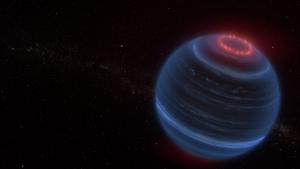Blog
Methane Aurora
29 April 2024
 NASA, ESA, CSA, Leah Hustak (STScI)
NASA, ESA, CSA, Leah Hustak (STScI)Brown dwarfs span the line between planets and stars. By definition, a star must be massive enough for hydrogen fusion to occur within its core. This puts the minimum mass of a star around 80 Jupiters. Planets, even large gas giants like Jupiter, only produce heat through gravitational collapse or radioactive decay, which is true for worlds up to about 13 Jovian masses. Above that, deuterium can undergo fusion. Brown dwarfs lay between these two extremes. The smallest brown dwarfs resemble gas planets with surface temperatures similar to Jupiter. The largest brown dwarfs have surface temperatures around 3,000 K and look essentially like stars.
Because of this, it can be difficult to study brown dwarfs, particularly ones that don’t orbit other stars. Without much reflected or emitted light, we can’t easily analyze their spectra to determine their composition. Fortunately, some brown dwarfs do emit radio light thanks to their strong magnetic fields.
Planets such as Earth and Jupiter have strong magnetic fields, and this means they can trap ionized particles such as hydrogen. These charged particles then spiral along the magnetic field lines until they collide with the planet’s upper atmosphere, generating glowing aurora. On Earth, we see them as the Northern Lights. For brown dwarfs, we can’t see the visible light of their aurora, but we can detect their radio glow.
Recently a team looked at the auroral light from a brown dwarf known as W1935.1 It is a cold brown dwarf 47 light-years from Earth with a surface temperature of just 200 °C. Within the spectra the team found light emissions from methane. While the presence of methane was expected in cold brown dwarfs, the fact that the methane emitted light was not. This means the atmosphere of W1935 likely has a thermal inversion, where the upper atmosphere is warmer than the lower layers.
This is true for the atmosphere of Earth but is driven by solar radiance. W1935 doesn’t orbit a star, so how can its upper atmosphere get so warm? One possible explanation is that the brown dwarf has an undetected small companion. This companion could be ejecting material similar to the way Saturn’s moon Enceleadus ejects water vapor. Once ionized in the vacuum of space, it would become trapped by the magnetic fields of W1935, eventually colliding with the brown dwarf’s upper atmosphere and giving it a bit of thermal heating.
This discovery shows that even the smallest brown dwarfs defy easy classification. Though they resemble planets, they may have their own planetary system like a star.
Faherty, Jacqueline K., et al. “Methane emission from a cool brown dwarf.” Nature 628.8008 (2024): 511-514. ↩︎